Crucial Advice to Protect Against Frozen Plumbing in Cold Weather
Crucial Advice to Protect Against Frozen Plumbing in Cold Weather
Blog Article
Presented here underneath you can get some good additional info regarding How To Avoid Freezing Pipes.

Cold weather can damage your pipes, specifically by freezing pipes. Below's how to stop it from happening and what to do if it does.
Introduction
As temperature levels decrease, the risk of icy pipes boosts, potentially bring about expensive fixings and water damage. Comprehending how to stop frozen pipelines is essential for house owners in chilly environments.
Prevention Tips
Insulating prone pipes
Cover pipelines in insulation sleeves or utilize heat tape to secure them from freezing temperatures. Focus on pipelines in unheated or exterior locations of the home.
Heating methods
Maintain interior rooms adequately warmed, particularly areas with pipes. Open up cabinet doors to enable warm air to circulate around pipelines under sinks.
How to determine icy pipes
Look for decreased water flow from taps, unusual odors or noises from pipelines, and visible frost on revealed pipes.
Long-Term Solutions
Structural changes
Consider rerouting pipes far from exterior wall surfaces or unheated areas. Include additional insulation to attic rooms, basements, and crawl spaces.
Upgrading insulation
Invest in high-grade insulation for pipes, attic rooms, and walls. Proper insulation assists preserve constant temperature levels and reduces the danger of frozen pipes.
Shielding Exterior Plumbing
Yard tubes and outdoor taps
Detach and drain garden pipes before winter months. Set up frost-proof spigots or cover outdoor faucets with insulated caps.
Understanding Frozen Pipelines
What creates pipelines to freeze?
Pipelines ice up when subjected to temperatures listed below 32 ° F (0 ° C) for expanded durations. As water inside the pipes freezes, it increases, putting pressure on the pipe walls and potentially triggering them to burst.
Dangers and damages
Icy pipelines can cause water system disturbances, building damages, and costly fixings. Ruptured pipes can flood homes and cause substantial architectural damage.
Indicators of Frozen Pipes
Determining frozen pipes early can prevent them from breaking.
What to Do If Your Pipes Freeze
Immediate activities to take
If you believe frozen pipes, keep faucets open up to alleviate pressure as the ice thaws. Utilize a hairdryer or towels soaked in warm water to thaw pipes slowly.
Final thought
Stopping frozen pipelines needs positive measures and fast actions. By understanding the causes, indicators, and safety nets, home owners can safeguard their plumbing throughout cold weather.
5 Ways to Prevent Frozen Pipes
Drain Outdoor Faucets and Disconnect Hoses
First, close the shut-off valve that controls the flow of water in the pipe to your outdoor faucet. Then, head outside to disconnect and drain your hose and open the outdoor faucet to allow the water to completely drain out of the line. Turn off the faucet when done. Finally, head back to the shut-off valve and drain the remaining water inside the pipe into a bucket or container. Additionally, if you have a home irrigation system, you should consider hiring an expert to clear the system of water each year.
Insulate Pipes
One of the best and most cost-effective methods for preventing frozen water pipes is to wrap your pipes with insulation. This is especially important for areas in your home that aren’t exposed to heat, such as an attic. We suggest using foam sleeves, which can typically be found at your local hardware store.
Keep Heat Running at 65
Your pipes are located inside your walls, and the temperature there is much colder than the rest of the house. To prevent your pipes from freezing, The Insurance Information Institute suggests that you keep your home heated to at least 65 degrees, even when traveling. You may want to invest in smart devices that can keep an eye on the temperature in your home while you’re away.
Leave Water Dripping
Moving water — even a small trickle — can prevent ice from forming inside your pipes. When freezing temps are imminent, start a drip of water from all faucets that serve exposed pipes. Leaving a few faucets running will also help relieve pressure inside the pipes and help prevent a rupture if the water inside freezes.
Open Cupboard Doors
Warm your kitchen and bathroom pipes by opening cupboards and vanities. You should also leave your interior doors ajar to help warm air circulate evenly throughout your home.

We hope you enjoyed reading our section about How to Prevent Your Pipes From Freezing. Thanks a lot for spending some time to read through our article post. Sharing is caring. Helping others is fun. Thank you for being here. Kindly come visit our blog back soon.
Book A Service Call Report this page